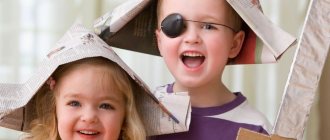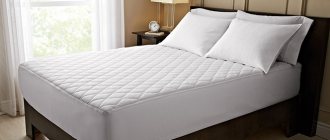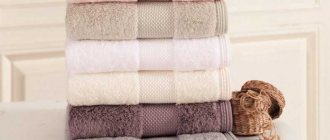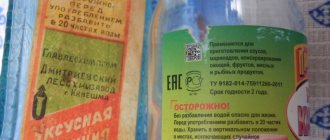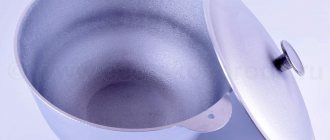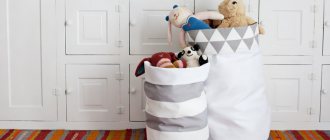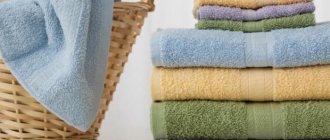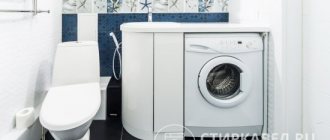How to calculate hat size using measurements
Without the parameters of your baby's head, it is difficult to choose a well-fitting hat for him. You can “study” the labels on bonnets you have already purchased or use the experience gained when purchasing bonnets for your firstborn. But since in newborns the head volume increases by at least 2 cm every month, and in older children - by 5 mm annually, and each baby develops at an individual speed, it is better to determine the size of the headdress using fresh measurements taken from a particular child.
How to take measurements
To determine the size of a cap for a newborn or a hat for a schoolchild, you need to measure the head circumference using one of two methods:
- Centimeter tape. Determine the center of the forehead, place the end of the tape and wrap it around the head so that it passes over the eyebrows and along the protruding area at the back of the head. The number on the tailor's centimeter is the size of the child's head.
- Sewing thread and ruler. Wrap the thread around your forehead and back of your head according to the principle described above. When both ends of the thread meet in the center of the forehead, cut it and measure it with a ruler, placing it on a flat surface.
How to correlate the resulting number with the markings on the header
how to determine head circumference
Domestic manufacturers use the simplest and most intuitive sizing charts for children's hats. The values printed on the caps they sell are equal to the circumference of the head in centimeters. Three-year-old preschoolers usually fit hats with a mark on the label of 50, that is, in most cases, the head size at 3 years is 50 cm.
Products from some companies are sewn according to the size grid not every 1 cm, but every 2, taking into account only even values: 46, 48, 50. Often double markings are found on hats: 38–40 or 36–38. They indicate that the product is made of fabric that stretches well, so it fits both parameters. It’s just that in the first case it fits tightly around the head, and in the second it’s loose.
We recommend
If the label of the cap indicates a paired format, purchase a product with a smaller first number and a suitable second number, since when worn, the fabric will stretch and it will fit. It is advisable to choose winter hats for infants with the same first number and a larger second number, since they are worn on a cap.
Fractional designations are rarely indicated on tags: 36/56, 40/62. The first number is the head circumference, the second is the height. An additional indicator helps you navigate if the cap is selected taking into account the average parameters characteristic of children of a certain age, and the child develops non-standardly, for example, overtakes his peers in height. Then you should adhere not to the numbers indicated in the tables of head sizes by month, but to individual parameters.
For example, a cap marked 40 should suit a six-month-old baby, since the head circumference at this age is usually 40 cm. But if you can’t check this fact by taking measurements, but you are sure that the baby’s height has exceeded 68 cm, then it is better to purchase the product marked 44/68 rather than 40/62.
Tips for choosing
The main criteria for choosing children's hats: material and style. As for fabric or yarn, you should give preference to models made from natural raw materials. For better fit, the presence of elastane fibers is acceptable (no more than 3%). Comfort and safety depend on the composition of the material. It is not recommended to choose synthetic products for a child. In winter, wearing such hats is cold, in summer it is too hot and unsafe.
Of synthetic materials, it is allowed to use fleece as a lining and membrane in the manufacture of the upper part. Such models are suitable for short walks in windy weather.
The style of hats depends on the time of year. For winter cold, it is advisable to choose hats with ear flaps, helmets, and various knitted options. On the eve of summer, hats, panamas, bandanas, and caps are selected.
How to determine head size in children by age: tables
Some hats only indicate the baby's age. It is not worth selecting a product based on this indicator, since the child’s body develops according to an individual pattern. It is better to try on a hat or check the sizing chart that manufacturers use to determine the parameters of children by age. For example, at what age is head size 52?
On a note
It should be taken into account that the head sizes indicated in the tables for newborns and adolescents are inaccurate, since they are statistically average and were determined for children of certain age groups with standard development. But since each child is unique and subject to the influence of genetics, the values of the measurements taken from him may differ significantly from the generally accepted ones.
Newborn head size by month:
| Age (months) | Head circumference = cap marking | Height (min-max) |
| Boys | ||
| 0 | 34–39 | 44–56 |
| 1 | 37–41 | 49–60 |
| 2 | 39–43 | 52–64 |
| 3 | 41–45 | 55–68 |
| 6 | 43–47 | 61–74 |
| 9 | 45–48 | 65–79 |
| 12 | 47–49 | 67–83 |
| Girls | ||
| 0 | 32–38 | 44–55 |
| 1 | 37–42 | 48–60 |
| 2 | 39–44 | 51–63 |
| 3 | 41–46 | 53–66 |
| 6 | 42–46 | 60–72 |
| 9 | 43–47 | 63–77 |
| 12 | 47–49 | 66–82 |
Sizes of hats for children 1–5 years old:
| Age (years) | Head circumference = cap marking | Height |
| Boys | ||
| 1 | 47–49 | 67–83 |
| 1,5 | 48–50 | 74–90 |
| 2 | 48–51 | 79–97 |
| 3 | 49–52 | 85–107 |
| 4 | 51–53 | 90–116 |
| 5 | 52–54 | 96–124 |
| Girls | ||
| 1 | 45–48 | 66–82 |
| 1,5 | 47–49 | 72–89 |
| 2 | 48–50 | 77–96 |
| 3 | 49–51 | 84–106 |
| 4 | 50–52 | 90–116 |
| 5 | 51–53 | 95–124 |
Additionally, see: tables of newborn clothing sizes by month.
Sizes of children's hats by age: 5–14 years:
| Age | Head circumference | Height |
| Boys | ||
| 6 | 52–54 | 101–131 |
| 7–8 | 52–55 | 105–144 |
| 9–10 | 53–56 | 114–156 |
| 11–12 | 54–57 | 131–163 |
| 13–14 | 54–58 | 141–176 |
| Girls | ||
| 6 | 51–53 | 100–130 |
| 7–8 | 51–54 | 104–144 |
| 9–10 | 52–54 | 114–158 |
| 11–12 | 52–55 | 131–163 |
| 13–14 | 52–55 | 143–171 |
We measure the child
Children's sizes are taken in the same way as adults:
- Height We ask the child to take off his shoes and lean his back against the wall. We make a mark at the highest point of the head. We measure the distance from the floor to the mark.
- Chest, waist and hips. We use a measuring tape to wrap around our model along lines 2, 3 and 4, marked in the figure below.
- The length of the sleeve. From the top of the shoulder to the first knuckle of the thumb. The arm should be slightly bent at the elbow, as in the figure.
- Inseam length. This is the distance from the ankle to the middle seam of the trousers.
Additionally: A detailed grid of the child’s height and age is here.
The sizes of children's clothing are recorded in centimeters; we have given the correspondence tables for them above.
Important! When taking measurements around the circumference of the waist, hips and chest, do not tighten the measuring tape too tightly or allow it to sag. We only achieve a tight fit and horizontal position relative to the floor
What to do if there is a foreign marking on the header
The designations on the labels of clothing from Europe and the USA differ from those indicated on Russian items. When purchasing hats in foreign boutiques and online stores, you should convert domestic sizes to foreign ones using a comparison table.
| Head circumference | Letter mark | England | France | USA |
| 47 | – | 5 | 0 | 5 7/8 |
| 49 | S/M | 6 | 1 | 6 1/8 |
| 51 | XXS | 6 1/4 | 2 | 6 |
| 53 | XS | 6 1/2 | 3 | 6 5/8 |
| 55 | S | 6 3/4 | 4 | 6 |
| 57 | M | 7 | 5 | 7 |
We also recommend the article: American clothing sizes in Russian (comparative tables).
Finally
It is best to try things on before buying, but many beautiful and high-quality children's clothes are sold in online stores. Don't be afraid to buy if you have made the necessary measurements, found out the size you need and indicated it to the seller.
Your attentiveness and our table will make shopping for your child easy and enjoyable.
How to make sure the numbers on labels are correct
Size charts used by branded brands may not correspond to the basic ones. To make the right choice, ask if the website has its own table of sizes of hats for children, or search for the necessary information online using the query “brand name Size Chart (size chart).”
See additionally: clothing sizes for children by age.
We recommend
You can check whether a hat with an unclear designation will fit your child by measuring it. Connect the edges of the product, smooth it and measure the length of the resulting semicircle. Multiply the identified number by 2 to calculate the circumference. Add 10 millimeters. The final number is the estimated head circumference.
Differences in size numbering from different manufacturers
Manufacturers of hats use 4 options for size numbering.
- dimensions with intervals equal to 1;
- sizes with even number intervals: 2-4;
- double sizes;
- combinations of sizes: age - size, height - size.
There are manufacturers who meet the needs of consumers; they supply hats with a size stabilizer.
What to do if the hat doesn't fit
Knowing at what age head size is 54 and at what age it is 56, you can purchase or sew a hat without calculating the exact parameters of the baby.
If the purchased clothing turns out to be too tight or too big, you can return it to both the online and offline store. The hat is included in the list of goods that can be returned even if the quality is indicative, if they do not fit the parameters, style or color. But the seller has the right to exchange the product for the right one, then a refund is possible only if a suitable hat is not available. To return or exchange an item, three conditions must be met:
- Maintain its integrity.
- Provide a receipt or any alternative document confirming payment.
- Contact the store to request an exchange of goods within 2 weeks from the date of purchase.
The seller may refuse to accept returns of knitted hats, as well as knitted scarves, scarves, mittens, and scarves, since outerwear items made of yarn are included in the list of items that cannot be returned. You can increase it yourself by steaming it from the inside out and stretching it in a warm, damp state. It is easy to re-adjust a piece that is too large when hand-washing hot. And if there is no risk of spoiling the design, it can be done by machine.
A large hat made of wool can be felted, but be extremely careful, otherwise it will shrink by half or even three times. Dip it in boiling water, gradually increasing the temperature until it fits “as if tailored to order.”
© 2022 textiletrend.ru
What hats should a baby have?
Preparing for the birth of a child must necessarily include the purchase of all the necessary supplies for the baby. Our mothers and grandmothers were careful not to buy anything before the baby was born, but we should not believe such superstitions. In advance, before birth, purchase a dowry for the baby: a crib, a stroller, diapers, care products, clothes.
A hat is a mandatory item of clothing. The body of a newborn baby still does not cope well with thermoregulation, and the main outflow of heat occurs through the head. In most maternity hospitals, it is customary to put a hat on the baby immediately after birth. For these reasons, a hat for a newborn should be purchased in advance.
